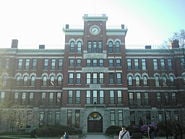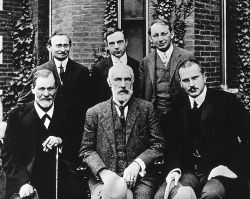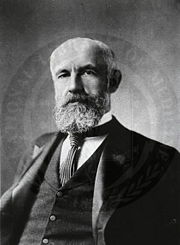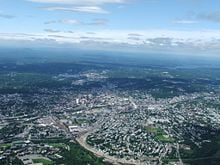Clark University

| |
| Motto | Fiat Lux (Latin) (Let There be Light) |
|---|---|
| Established | 1887 |
| Type | Private |
| Location | |
| Website | www.clarku.edu |
Clark University is a private research university and liberal arts college in Worcester, Massachusetts. Founded in 1887 by the industrialist Jonas Clark, it is the oldest institution founded as an all-graduate university. Clark now also educates undergraduates. It is one of only three New England universities, along with Harvard and Yale, to be a founding member of the Association of American Universities. Clark withdrew membership from the Association of American Universities in 1999 due to its shift from research to undergraduate education. Nevertheless research is still funded at Clark University despite their emphasis on undergraduate education.
Clark offers the only program in the country leading to a Ph. D. in Holocaust History and Genocide Studies. Sigmund Freud spoke only at Clark University during his single trip to the United States.
Mission and Reputation
Clark University describes its mission as "to educate undergraduate and graduate students to be imaginative and contributing citizens of the world, and to advance the frontiers of knowledge and understanding through rigorous scholarship and creative effort."[1] Clark University strives to achieve this goal by incorporating a strong traditional liberal arts educational experience along with fostering a sense of intellectual curiosity in each of its students. Even though its main focus is now on undergraduate education, Clark still maintains respected graduate level programs and research programs, which, in conjunction with its relatively small size, gives its undergraduate students exposure to a wide range of academic experiences, and fosters a close bond between undergraduate, graduate, and facility members which increases the intellectual experience of all involved.
Clark University was ranked 80th in the U.S. by the 2008 U.S. News and World Report "2009 Best Colleges" report, and has consistently been within the top 100-150 private liberal arts schools in the US.[2] Clark has developed a reputation as a free-thinking institution. Clark has been noted especially for its geography and psychology departments, with the latter having a distinctive, if increasingly unfashionable "humanistic" orientation.
History
Clark University was first established in 1887 by successful business man and industrialist Jonas Clark, who established the school after developing an interest in higher education. At first the university only offered doctoral programs, the first institution in the US to do so.[3]
Clark's first president, G. Stanley Hall was a major influence on the development of American psychology, as the founder of the American Psychological Association, and helped make Clark University the epic center for the psychological movement. Hall played a particularly important role by inviting Sigmund Freud to deliver what later became known as his famous Clark Lectures in 1909, which helped introduce Freud's theories of psychoanalysis to the U.S.[3]

In 1902, the university started to offer undergraduate level degrees and programs. During most of the twentieth century, Clark remained a small, yet prestigious school. While the school did shift towards focusing in undergraduate education, it never left behind its roots in research and advanced study, particularly in specialized or traditionally under represented fields. Clark was one of the first colleges to develop a Geography department, one which has become renowned for its innovation and rigor. The school also maintained strong relations with the local industrial community, and benefited from such ties, both in endowments and from the growth of a local community of several other colleges that gave its students an ideal place to come and study. In 1985, the university engaged in a partnership with community groups and business organizations to revitalize Clark neighborhoods. Its efforts in the University Park Partnership program include refurbishing dilapidated or abandoned homes, reselling them to area residents, and subsidizing mortgages for new home buyers.[4]
Facilities
Clark University offers eight libraries:
- Academic Commons at Goddard Library
- Guy Burnham Map and Aerial Photography Library
- Carlson Science Library
- Jeanne X. Kasperson Research Library
- Rose Library in Cohen-Lasry House
- Traina Center Resource Library
- Language Arts Resource Center
- Worcester Consortium Libraries
Clark has several different facilities for the arts, including the Traina Center for the Arts which houses galleries, research facilities and lecture centers, the Little Center, Clark's theater building that includes performances spaces, and workshops for costume, set and prop design and the Schiltkamp Gallery which exhibits works of many different artist mediums.
The University has several different athletic related facilities, both for organized sports and for recreational use, such as the Kneller Athletic Center and Bickman Fitness Center.
Programs
Clark University offers 31 undergraduate majors, most of which fall into the traditional paradigm of liberal arts. Some of the unique undergraduate programs offered include Urban Education, Geographic Information Sciences (GIS), Holocaust and Genocide Studies, and International Development and Social Change. Clark's graduate program offers 7 PhD and 12 Graduate level programs, with programs in psychology, History, and Business being some of the most popular.
In recent years, Clark has received widespread media coverage for its "Fifth-Year Free" program. Under Clark's BA/MA program with the fifth year free, undergraduates who maintain a B+ average are eligible for tuition-free enrollment in its one-year graduate programs, meaning that they can get a Master of Arts degree for the price of a bachelor's degree. Students apply to master's degree programs in their junior year, begin meeting requirements in their senior year and typically complete those requirements in the fifth year. Bachelor's degrees are granted en route to the master's degree.
Clark also offers an extensive Study Abroad program, a 3/2 Engineering program which allows students to study for three years at Clark and then a final two years of study at an engineering school, which leads to both an undergraduate and graduate degree. Clark participates in the Colleges of Worcester Consortium which allows all undergraduate students except freshmen from registering for one class per term at one of the other colleges in the consortium.
In 1997, Clark opened a secondary public school, the University Park Campus School (UPCS), that is also a professional development school for Clark’s teacher education program. Because of its long hours and demanding curricula, UPCS has been lauded as a model for collaboration between a university and an urban district. Students are able to attend Clark University free of charge upon graduation, provided they meet certain residency and admissions requirements.
Departments and Institutes
Clark University does not divide itself into different colleges like some of the larger universities; rather, academics are broken down into specialized departments that oversee one or two different programs of study. There is a distinction made between undergraduate and graduate schools.
Clark has several research institutes and centers:
- The William and Jane Mosakowski Institute for Public Enterprise
- The Strassler Family Center for Holocaust and Genocide Studies
- The Center for Community-Based Development (CCBD)
- The Jacob Hiatt Center for Urban Education
- The George Perkins Marsh Institute for human-environment relationships and the human dimensions of global environmental change. The George Perkins Marsh Institute is a consortium of four research centers:
Student life
The surrounding area of Worcester also offers students many opportunities, offering an urban environment without being a major metropolitan area. The college is only fifty miles from the city of Boston. Historical Worcester has many colleges located near the city limits, helping to create a college town environment where Clark students can mingle with other college students, explore the museums and history of the area.[4]
Clark University's student population has become increasingly more diverse and even international, attracting students with its unique programs. Clark offers twenty-four different residential buildings, requiring underclassmen to live on campus for a specific amount of time but also does its best to accommodate all students.[5] Clark offers clubs that range from Arts and Crafts to Nature and regional excursions. The several arts facilities and galleries on campus allow students the opportunity to participate in and experience many different artist activities. Clark is a Division 3 athletic conference, offering both men's and women's sports, such as Baseball, Softball, Lacrosse, Crew, and Cross Country Track. The school also offers intramural sports for such activities as Soccer. Students are also able to take advantage of the athletic and recreational facilities, including a gym, pool, and recreational classes.[4]
Traditions
Every fall the university has what is called Spree Day, where students present their work, whether it be artistic or intellectual. Students' works are exhibited in Higgins University Center for a day, along with the students who created them. The entire college, along with the Worcester community, is invited to attend, where they can view the works and interact with the students whose works are presented.[4] The tradition gives the students both an opportunity to show off their achievements as well as market themselves and make connections.
Notable alumni and Faculty
Following are some of those affiliated with Clark University, alumni and renowned faculty who have taught at Clark:
Alumni
- E. Franklin Frazier - Sociologist, analyzed the cultural and historical forces that influenced the development of the African American family from the time of slavery, famous for his work The Negro Family in the United States in 1939, .
- Solomon Lefschetz - Mathematician, did fundamental work on Algebraic topology, its applications to Algebraic geometry, and the theory of non-linear ordinary differential equations.
- Margaret Morse Nice - Ornithologist, made an extensive study of the life history of the Song Sparrow, author of Studies in the Life History of the Song Sparrow (1937).
- W. S. Small - Experimental psychologist, the first person to use the behavior of rats in mazes as a measure of learning.
- Frederick M. Smith - Religious leader, author, and a Prophet-President of the Community of Christ Reorganized Church of Jesus Christ of Latter Day Saints, now renamed Community of Christ.
- Lewis Madison Terman - Pioneer in cognitive psychology, best known as the inventor of the Stanford-Binet IQ test.
- Albert Potter Wills - Notable for his work on magnetic materials and also for having been the Ph. D. adviser of the Nobel Prize winner Isidor Isaac Rabi.
- Miriam Van Waters - Noted early American feminist social worker and served as superintendent of the Massachusetts Reformatory for Women at Framingham.
Faculty
- Wallace Walter Atwood - Geographer and Geologist, famous for his idea of Global Species Consolidation.
- Franz Boas - Considered the "Father of American Anthropology," famous for his theory of Cultural relativism.
- Edwin G. Boring - Pioneer in psychology during the first half of the twentieth century, famous for chronicling the history of psychology.
- Robert H. Goddard - Pioneer of controlled, liquid-fueled rocketry.
- G. Stanley Hall - Famous psychologist who focused on childhood development, evolutionary theory, and their applications to education (also a Clark alumnus).
- Tamara Hareven - Social historian who wrote extensively on the history of the family and the effects of social changes on family lives.
- Wolfgang Köhler - Famous psychologist who developed and promoted Gestalt psychology.
- Albert Abraham Michelson - First American to win a Nobel Prize, for science, physicist famous for measuring the speed of light.
- Ellen Churchill Semple - Geographer, most closely associated with work in human geography and environmentalism.
Notes
- ↑ Clark University, Clark University Mission Statement Academic Advising, Clark University, 2008. Retrieved November 16, 2008
- ↑ Best Colleges, "Clark University" Best Colleges, U.S. News and World Report, 2008. Retrieved November 16. 2008
- ↑ 3.0 3.1 History About Clark, Clark University, 2008. Retrieved November 16, 2008
- ↑ 4.0 4.1 4.2 4.3 Mike Bertone, Clark University (College Prowler, 2006, ISBN 1427402329)
- ↑ Clark University, "About Residential Life & Housing" Residential Life & Housing, Clark University, 2008. Retrieved November 17, 2008
ReferencesISBN links support NWE through referral fees
- Bertone, Mike. Clark University. College Prowler, 2006. ISBN 1427402329
- Clark, Susan Wright. In Memoriam, Jonas Gilman Clark. New Library Press, 2007. ISBN 978-0795010507
- Hall, Granville. Letters to Jonas Gilman Clark. Reprint Services Corp, 1948. ISBN 0781285437
- Shilkret, Robert. Clark University, International Dictionary of Psychoanalysis. The Gale Group, Inc., 2008. Retrieved November 19, 2008.
- Rosenzweig, Saul. Freud, Jung, and Hall the King-Maker: The Historical Expedition to America. Ranch House Press, 1993. ISBN 0889371105
External links
All links throughout this article retrieved November 23, 2008.
- Clark University Homepage
- Clark University Graduate School of Management
- University Park Campus School
- Colleges of Worcester Consortium Homepage
Credits
New World Encyclopedia writers and editors rewrote and completed the Wikipedia article in accordance with New World Encyclopedia standards. This article abides by terms of the Creative Commons CC-by-sa 3.0 License (CC-by-sa), which may be used and disseminated with proper attribution. Credit is due under the terms of this license that can reference both the New World Encyclopedia contributors and the selfless volunteer contributors of the Wikimedia Foundation. To cite this article click here for a list of acceptable citing formats.The history of earlier contributions by wikipedians is accessible to researchers here:
The history of this article since it was imported to New World Encyclopedia:
Note: Some restrictions may apply to use of individual images which are separately licensed.

